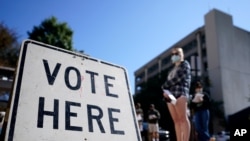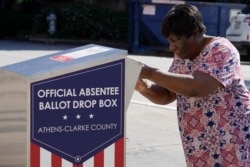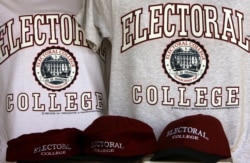Ahead of the 2020 U.S. presidential election, political scientists and election law experts gamed out a variety of scenarios the nation could face on Election Day and in the weeks that follow. The possibilities vary between a clear cut victory by either President Donald Trump or former Vice President Joe Biden, and an unresolved legal battle that leaves the outcome uncertain into January, when the new Congress is supposed to certify the election's final result.
Experts say determining the winner of this particular election is especially fraught because of an unprecedented level of absentee voting due to the coronavirus pandemic. Variation in laws among the states about how and when to count absentee ballots means that a final count could take days or weeks to complete.
In what he called the "nightmare scenario," political scholar William Galston of the nonprofit Brookings Institution writes that a closely contested election in which the outcome is in doubt would "[throw] the country into chaos under highly adverse circumstances."
Trump has repeatedly raised the possibility that the massive use of mail-in ballots will result in a fraudulent election result and has repeatedly refused to commit in advance to a peaceful transfer of power if he loses. Biden has said he would accept the election results, provided there is a fair vote count.
Given the potential unrest that a contested election could trigger, the best case scenario may be a certain or near-certain outcome on election night, which is well within the realm of possibility. But the nature of the U.S. system for choosing a president leaves open multiple different outcomes.
A complex process
The U.S. presidency is not awarded on the basis of the national popular vote. U.S. presidential elections are decided through a complex two-step system in which state-level votes are followed by a second vote in a body known as the Electoral College. Individual states are allotted a certain number of "electors," based on population, and a slate of electors supporting the winner of the popular vote in each state is certified once the votes have been counted. (In two states, Maine and Nebraska, it is possible for candidates to split the available electoral votes.)
Polling in individual states suggests that despite trailing in the national polls, Trump could win reelection with a minority of the popular vote, as he did in 2016, by winning in the Electoral College.
The Electoral College convenes on December 14 for the vote that officially determines who the next president will be. A candidate must receive 270 votes out of a total of 538 to claim victory. The votes are formally counted at a joint session of the House and Senate on January 6.
While there are many states that will take days or even weeks to process all of their votes, a number of states central to the outcome of the vote are expected to announce complete or near-complete counts on the evening of the election or early the next day.
Chief among these is Florida, a state that Trump carried in 2016 and where he and Biden are now locked in a close race. A victory by Biden would garner him 29 electoral votes and close down nearly all avenues to victory for Trump. North Carolina, with 15 electoral votes, and Arizona with 11, also important to most scenarios in which Trump comes out ahead, are also likely to report early.
"There's good reason to believe that those states might be able to get close to a complete count late on election night, or by the next morning," said Richard H. Pildes, an election law expert and professor of constitutional law at New York University. "And so if we know, for example, that President Trump has lost Florida, then even though Michigan and Pennsylvania and Wisconsin might not have completed their counts, we would have very good reason to have high confidence that Biden is going to win the election."
Michigan has 16 electoral votes, Pennsylvania has 20 and Wisconsin has 10.
Pildes added that in a scenario where Florida is too close to call on the night of the election and other early reporting states are split between the candidates, things could become contentious very quickly.
Potential legal battles
"If the outcome is uncertain by, let's say the early morning the next day, because there are significant states that can't get to a full count because of the massive volume of absentee ballots that still have to be counted ... then what I would expect to happen is intense disputes in those states about each and every one of those absentee ballots, and whether they should be treated as validly cast," Pildes said.
There are some key milestones between Election Day and the counting of the votes by Congress on January 6. The first of these is December 8, the so-called "safe harbor" date by which states are expected to submit certified slates of electors to the Archivist of the United States.
In the event a state has not completed its vote count by that date, either because of ongoing counts or legal actions, there is a provision in federal law that allows the state's legislature to convene and appoint a slate of electors without knowing the final vote tally. This creates the possibility that a partisan legislature could appoint a slate of electors supporting the candidate who ultimately loses the state's popular vote.
In states where the governor and the legislature are split between parties, there is another complicating factor. Because it is the governor who officially certifies the slate of electors after a vote, it is possible that a state could submit two slates of electors, both with a plausible claim to legitimacy.
Under federal law, if the new Congress is presented with two competing slates of electors from the same state, the House and Senate vote to determine which will be accepted. If they agree, the slate they choose is counted. If they disagree, the slate certified by the governor prevails.
An Electoral College tie
It is also possible, though unlikely, that there could be no winner of the presidency even after the electoral vote is counted. If both candidates finish with 269 votes, deciding who wins the election becomes the responsibility of the House of Representatives. However, instead of a vote in which all 438 members vote individually, the delegations for each state vote as a whole, meaning that the dominant party in each state would control its vote.
Such a result would give the roughly 600,000 citizens in Wyoming as much leverage in selecting the president as the 40 million citizens in California.
A final wrinkle in the system is the possibility that some of the electors sent to vote for president on December 14 could turn out to be "unfaithful." In a limited number of cases over the years, electors pledged to vote for a specific candidate have cast their ballot in the Electoral College for a different candidate.
Several states have passed legislation binding electors to vote as they pledged, and the Supreme Court has ruled that such restrictions are legal. It remains possible that unfaithful electors could attempt to sway the election, but experts point out that doing so successfully would require both a very close election result and an unlikely degree of coordination among electors.
It is important to note that while possible, most of these scenarios are unlikely to arise.
Professor Pildes, of New York University, stressed that even without a complete count on election night, it could be reasonably clear who the winner is going to be in the end.
"Even in states that can't complete their counts, individual counties in those states may very well complete their counts," he said. "And the media is going to compare how Trump is doing in 2020 in those counties to how he did in 2016. And if he is systematically underperforming or overperforming compared to that baseline, that's going to be highly revealing information that might signal very strongly where the election is going, even if a winner cannot formally be declared ... I think that might be as likely a scenario as any."












